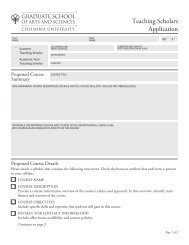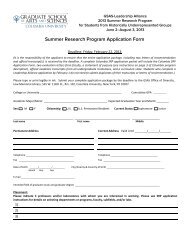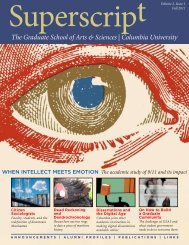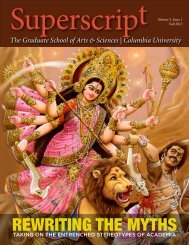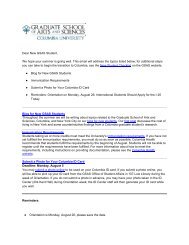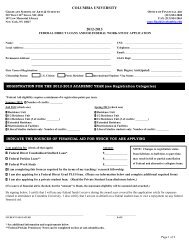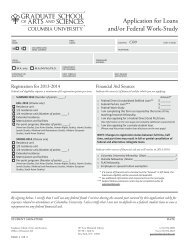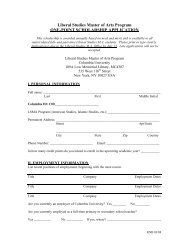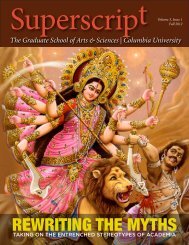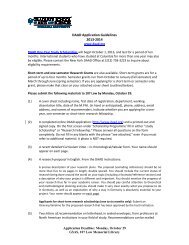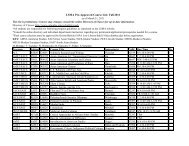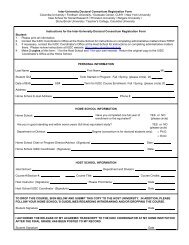PDF for Printing - Graduate School of Arts and Sciences - Columbia ...
PDF for Printing - Graduate School of Arts and Sciences - Columbia ...
PDF for Printing - Graduate School of Arts and Sciences - Columbia ...
- No tags were found...
You also want an ePaper? Increase the reach of your titles
YUMPU automatically turns print PDFs into web optimized ePapers that Google loves.
Pederson started working in the lab asa technician after completing his master’sdegree in <strong>for</strong>est ecology at Auburn University.He quickly became “hooked on treerings <strong>and</strong> went on to complete his Ph.D.in Earth <strong>and</strong> Environmental Science at<strong>Columbia</strong> in 2005. His primary researchfocuses on the “interaction between climate<strong>and</strong> ecology, how the climate impacts theenvironment.” He uses trees to reconstructan environment, <strong>and</strong> his reconstructionshave been used to further our underst<strong>and</strong>ing<strong>of</strong> drought, ecology, <strong>and</strong> carbon dynamics.Martin-Benito came to Lamont-Dohertyfrom Spain last September to study the<strong>for</strong>ests <strong>of</strong> Southeast Asia, the dynamicswithin those <strong>for</strong>ests, <strong>and</strong> their relation tothe environment. Despite their researchfocus on ecology, both Pederson <strong>and</strong>Martin-Benito were interested in the ship’sremains. Martin-Benito had read aboutthe ship in the newspaper prior to comingto the States. When he arrived at the lab tobegin his work, he was excited to have theopportunity to analyze the ship’s samples<strong>and</strong> learn about New York City history inthe process.Finding a ship in Manhattan is rare. Thelast such discovery was made in 1982 nearthe South Street Seaport. Like that ship,the one at the World Trade Center site hadlikely been sunk in the late eighteenth orearly nineteenth century when the city useddebris to exp<strong>and</strong> lower Manhattan into theHudson River. The site was close to whatwas once the location <strong>of</strong> Lindsey’s Wharf<strong>and</strong> Lake’s Wharf, <strong>and</strong> it had been leftundisturbed <strong>for</strong> at least two hundred years;its location was not included in the originalWorld Trade Center towers’ construction.The sizeable remains <strong>of</strong> the USS Adrian—named after the excavation site manager—<strong>and</strong> their condition also made this particularfind exciting. Approximately thirty feet<strong>of</strong> the wooden hull—estimated to be abouthalf <strong>of</strong> the original—was intact <strong>and</strong> relativelywell preserved in its encasement <strong>of</strong>sludge.Despite the general enthusiasm, Pederson<strong>and</strong> Martin-Benito had their concernsregarding the project. In total, 24 sampleswere taken from the keel, keelson, <strong>and</strong>planks <strong>of</strong> the ship; they were likely to be inan extremely unstable state from havinglain in mud <strong>for</strong> two centuries. Along withthe condition <strong>of</strong> the samples, Pederson hadquestions about the original condition <strong>of</strong>the ship itself as debris. “If the city decidedto sink a ship into a l<strong>and</strong>fill, something hadto be seriously wrong with it in the firstplace.” Moreover, the ship’s origins wereentirely unknown. If the Adrian had beenbuilt in a part <strong>of</strong> the world <strong>for</strong> which notree-ring chronologies have been derived,the study would come to an abrupt <strong>and</strong>disappointing end.Luck, however, was on their side. WhenMartin-Benito began examining thesamples, he discovered that they were inexcellent condition <strong>and</strong> sturdy enough toallow <strong>for</strong> drying <strong>and</strong> s<strong>and</strong>ing, making therings clearer to see <strong>and</strong> record. One samplewas identified as hickory, which meant thewood was from either eastern Asia or easternNorth America. Logic pointed to NorthAmerica, <strong>and</strong> since the remaining sampleswere oak—the species <strong>for</strong> which the labhad the best <strong>and</strong> most extensive chronologies—theproject quickly became a matter<strong>of</strong> matching a master chronology.Master chronologies are the lab’s records<strong>of</strong> historic tree-ring data from around thecountry, compiled by director <strong>and</strong> founderDr. Edward Cook over the last few decades.They are the “perfectly dated yearly series<strong>of</strong> tree-ring width” the lab uses to locatesamples in place <strong>and</strong> time <strong>and</strong> to tell thestory <strong>of</strong> regional <strong>for</strong>ests. Like written <strong>and</strong>oral accounts in history, the collective group<strong>and</strong> the individual tell slightly differentstories. “If you have one piece <strong>of</strong> wood<strong>and</strong> you want to compare it to a chronology,you could do that,” Pederson explains.“But if you had three or four from the same<strong>for</strong>est, you could date those <strong>and</strong> make amaster chronology by averaging out theLink back to contents page4 Superscript



